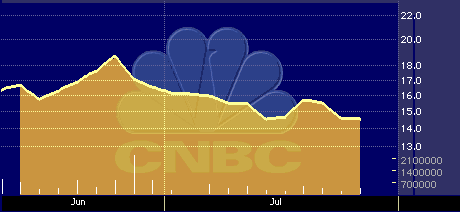
Agile Software Succeeds by Design
Agile Software Succeeds by Design
by Hal Plotkin
Silicon Valley Correspondent
Product-design software maker Agile Software Corp.’s {AGIL} has high hopes it can use its early success to become the dominant player in an emerging new market.
“Agile has at least a couple of years lead,” over would-be competitors, says Bruce Richardson, vice president of research strategy at AMR Research Inc., a software market-research firm based in Boston. “The company created a new product category. Right now, they have 100 percent mind share.”
San Jose, Calif.-based Agile produces specialized software that taps the power of the Internet to help companies better manage product design and pre-production processes, as well as coordinate design changes with outside suppliers.
The company’s stock went public on Aug. 20 at $21 a share, higher than the original price range of $15 to $17. Recently, the stock has been changing hands at more than twice its original offering price.

AGIL stock performance chart since its IPO
Many companies sell enterprise resource planning software that coordinates production processes within a single company. Agile’s products, on the other hand, are designed to help companies achieve a similar level of real-time coordination with outside suppliers.
“They’ve taken the next step,” says George Gilbert, an analyst at Credit Suisse First Boston Corp. based in San Francisco. “They’re focused on product information, not taking or processing an order.”
Two key trends are contributing to Agile’s growth: outsourcing and shorter product lifecycles.
Last year, 15 percent of all manufacturing in the United States was outsourced, a figure that’s projected to grow to 40 percent next year, according to a recent study by Hambrecht & Quist, based in San Francisco.
In recent weeks, for example, telecommunications supplier Ericsson {ERICY} sold its Visby, Sweden, manufacturing facility to Flextronics International Ltd. {FLEX}, a custom manufacturer with headquarters in San Jose, Calif.
Likewise, IBM {IBM} announced it would outsource manufacturing for its Netfinity servers to Milpitas, Calif.-based Solectron Corp. {SLR}.
Both Flextronics and Solectron are Agile Software customers. Other Agile customers include Texas Instruments Inc. {TXN}, Lucent Technologies Inc. {LU}, and GE Marquette Medical Systems. “The move toward outsourcing is critical for us,” says Bryan D. Stolle, Agile’s founder and CEO.
Check out Agile Software’s Web site
Stolle says outsourcing requires close coordination of growing supplier networks. “A lot of companies don’t really make anything anymore, they are design and marketing operations,” he says.
While most large companies already have internal computer systems that tie their different divisions together, Agile software helps eliminate divisions between companies so the impact of changes to designs or parts can be instantly assessed.
In essence, Agile is creating a kind of nervous system for companies involved in a design process.
“One of their real strengths is the way they’re creating a supplier daisy-chain,” Richardson says. “Once they get one company, say Solectron, they move down the chain to sign up Solectron’s suppliers, and then the companies who supply those companies, and so on.”
Solectron Shines in Outsourcing Sector by Hal Plotkin
Ever-shortening product lifecycles are also helping spur demand for Agile’s real-time design-coordination software, Richardson says. “We’re in the very early stages of what will be a huge market. Product lifecycles will only get shorter.”
Customers using Agile’s software, for example, change designs on the fly whenever less-expensive parts become available, or for any other reason. All companies involved are then immediately notified of the change to make sure no problems are inadvertently created.
“Our average customer makes 600 changes per week,” Stolle says. Although some of those changes can be quite minor, such as a change to the documentation for a product, “It’s important that everyone have the most current information,” he adds.
Right now, Agile is facing very little in the way of direct competition, Richardson says. Motiva Software Corp., a privately held firm based in San Diego, is targeting some of the same customers in partnership with San Rafael, Calif.-based Autodesk Inc. {ADSK}.
Meanwhile, the traditional ERP vendors, who might have been Agile’s most formidable competition, were slow to recognize the need to coordinate pre-production design processes. Several of the leading ERP suppliers, including Oracle Corp. {ORCL}, SAP AG {SAP}, and J.D. Edwards & Co. {JDEC}, are now working in partnership with Agile to link the company’s pre-production software to their own ERP products.
“We expect more competition.” Stolle says. “Our visibility is too high, and this is too interesting an opportunity for others not to want to get in. But we’ve put over $50 million in the last five years into what we’ve got, and it will be hard for anyone to compete with that kind of hands-on experience.”
At least some investors are betting that Agile’s early success will open up additional opportunities for the company.
“Brian Stolle is exploiting all the chains,” Richardson says. “ERP vendors might become alarmed when they realize how deeply he is getting into the DNA of their key industries.”
Eric Upin, an analyst at BancBoston Robertson Stephens, based in San Francisco, says he thinks Agile probably deserves its already high valuation.
“Technology companies are often richly valued,” he says. “But when you look at this company’s management team, customers, and market, I’d say emphatically yes, it’s worth its valuation. This is a very strong company going forward.”
Agile Software posted a loss of $4.1 million on revenue of $5.9 million for the fiscal first quarter ended July 31, compared with a loss of $2.6 million on revenue of $3.2 million for the same period last year.


